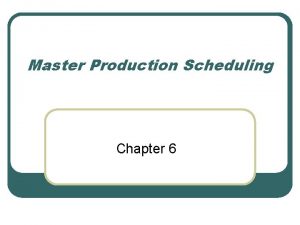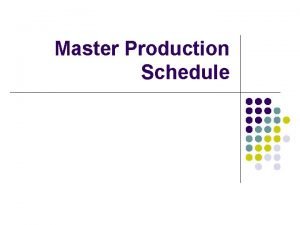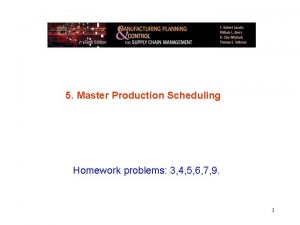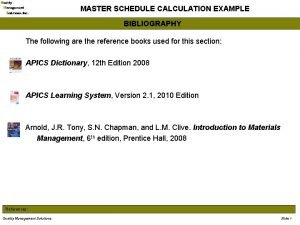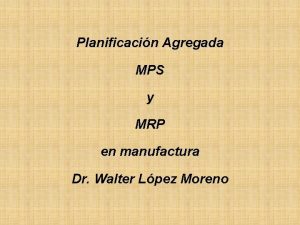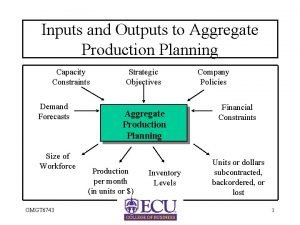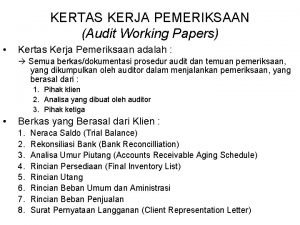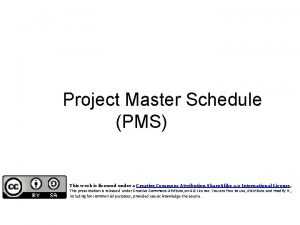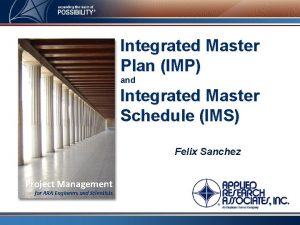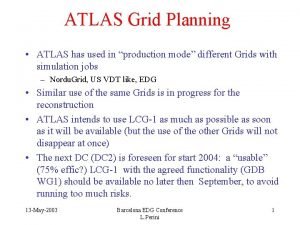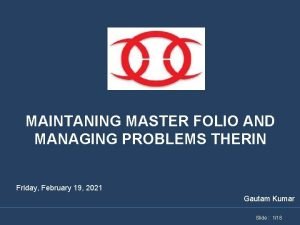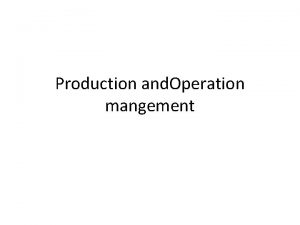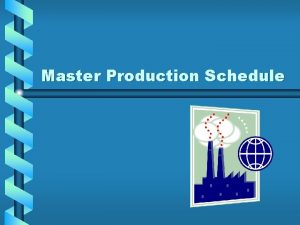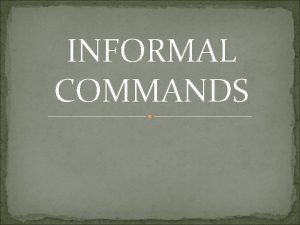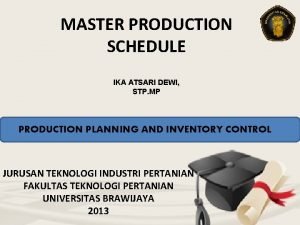Master Production Schedule Overview Define Master Production Schedule























- Slides: 23

Master Production Schedule

Overview Define Master Production Schedule Explain MPS Discuss How MPS Works Example From “Real Life” Brainstorm: How Can MPS Help Your Firm? Practice MPS

What is MPS? Master Production Schedule – States the requirements for individual end items by date and quantity.

MPS Explained Breaks down, or disaggregates, the production plan into product families Promotes valid order promises Provides a communication medium between Marketing/Sales and Operations

Explanation Continued Proactively control ability to deliver goods to customers Resource availability control Proactively control inventory levels

Objectives of Master Production Schedule (MPS) 1. Keeping the inventories at the desired level by making perfect use of the resources that are available with the company. 2. Setting up due dates for the availability of the end items and also providing the required information regarding resources and also the materials – which act as the supporting pillars of the aggregate planning. 3. Maintaining properly, the desired level of customer service. 4. Setting particular schedules for the production of the parts and the components that are used as the inputs to materials requirements planning, in the end items.

Disaggregate the Sales and Operations Plan The production plan is broken into product families

Promotes Valid Order Promises By validating the capacity for the MPS through cut capacity planning, alterative plans can be made when there are more orders than production

Marketing Operations Marketing communicates demand through customer orders and forecasts Operations communicates capacity through inventory levels and constraints

The main steps in master production schedule can be summarized as – 1. Forming a preliminary MPS. 2. Performing rough – cut capacity planning. 3. Resolving differences.

Resource Availability Control Production shortfalls will be known ahead of time and alternative plans can be made.

Customer Service Proactively control ability to deliver goods to customers

Why is it important to deliver to customers on time or when promised?

Inventory Control Proactive approach to inventory control Items are scheduled to arrive when needed Safety stock has less importance

Planning Organization

A good master scheduler always tries to consider the following five key questions before making any final decision for changing the master schedule – 1. Is there any real change in demand? 2. What is the impact on the production plan? 3. Is material available? 4. Is capacity available? 5. What are the risks involved? 6. What are the costs involved?

Inputs into the MPS Known Orders Demand Forecast Key Capacity Constraints Master Production Schedule (MPS) Sister Plant Demand Inventory Levels Spares Demand R&D Demand Exhibition/ Promotion Requirements Safety Stock Requirements

How MPS Works Information needed for MPS logic Lot Size Lead Time Product Demand Starting Inventory

Summary MPS breaks the Sales & Operations plan into product families Maintains Desired Level of Customer Service Allows proactive control of inventory

Forecast Customer Orders (Committed) Projected on-hand Inventory MPS Available to Promise JUNE 2016 1 2 3 4 5 6 7 8 30 30 35 60 40 20 40 40 20 15 10 4 2 10 10 5 5 10 - - 30 30 60 45 15 45 30 - 15 20 56 43 15 45 30 Calculating the Master Production Schedule (MPS) Opening Stock = 40 units Minimum Batch Size = 15 units JULY 2016

Forecast Units Customer Orders (Committed) Projected on-hand Inventory MPS Available to Promise Exercise 1 June July 1 2 3 4 5 6 7 8 9 150 125 145 160 170 180 210 155 220 35 20 15 10 5 Siyabonga Textiles, a manufacturer of women’s garments has compiled the following sales forecast for the months of June and July 2016: The opening inventory for this period was 50 units and the factory can only produce batches of 12 units. Calculate: Projected on hand inventory Master Production Schedule Available to Promise (ATP)

Forecast Units Customer Orders (Committed) Projected on-hand Inventory MPS Available to Promise Exercise 2 June July 1 2 3 4 5 6 7 8 9 4900 4500 5750 6200 4550 4985 5280 6560 7750 5100 4900 3750 2460 2155 1450 Nomvete Garments, a manufacturer of women’s garments has compiled the following sales forecast for the months of June and July 2016: The opening inventory for this period was 850 units and the factory cab only produce batches of 1200 units. Calculate: Projected on hand inventory Master Production Schedule Available to Promise (ATP)

Forecast Units Customer Orders (Committed) Projected on-hand Inventory MPS Available to Promise Exercise 3 June July 1 2 3 4 5 6 7 8 9 4500 5750 6100 4200 4800 5270 6560 5850 5100 4500 3750 2460 2155 1450 Siyafunda Fashion, a manufacturer of women’s garments has compiled the following sales forecast for the months of June and July 2016: The opening inventory for this period was 650 units and the factory can only produce batches of 1350 units. Calculate: Projected on hand inventory Master Production Schedule Available to Promise (ATP)
 12 principles of master production scheduling
12 principles of master production scheduling Master production schedule
Master production schedule Production scheduling example
Production scheduling example Master production schedule calculation
Master production schedule calculation Master production schedule calculation
Master production schedule calculation Master production schedule example
Master production schedule example Mrp inputs
Mrp inputs Post production adalah
Post production adalah Master data services overview
Master data services overview Master data management sql server
Master data management sql server Contoh working paper audit
Contoh working paper audit Master cleaning schedule servsafe
Master cleaning schedule servsafe Ssop checklist
Ssop checklist Master project schedule
Master project schedule Integrated master schedule example
Integrated master schedule example Aggregate planning and master scheduling
Aggregate planning and master scheduling Management myths in software engineering
Management myths in software engineering Production planning meaning
Production planning meaning Atlas production schedule
Atlas production schedule Plant master file
Plant master file What is master folio
What is master folio Define production
Define production Factors of production pictures
Factors of production pictures Www description
Www description
